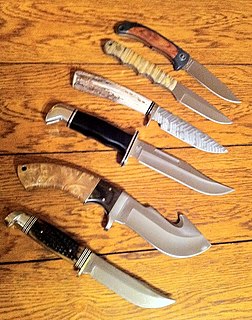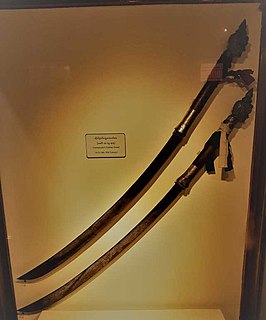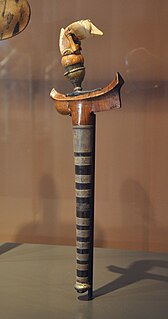Related Research Articles

A knife is a tool or weapon with a cutting edge or blade, usually attached to a handle or hilt. One of the earliest tools used by humanity, knives appeared at least 2.5 million years ago, as evidenced by the Oldowan tools. Originally made of wood, bone, and stone, over the centuries, in step with improvements in both metallurgy and manufacturing, knife blades have been made from copper, bronze, iron, steel, ceramic, and titanium. Most modern knives have either fixed or folding blades; blade patterns and styles vary by maker and country of origin.

Dao are single-edged Chinese swords, primarily used for slashing and chopping. The most common form is also known as the Chinese sabre, although those with wider blades are sometimes referred to as Chinese broadswords. In China, the dao is considered one of the four traditional weapons, along with the gun, qiang (spear), and the jian, called in this group "The General of Weapons".

A cutlass is a short, broad sabre or slashing sword, with a straight or slightly curved blade sharpened on the cutting edge, and a hilt often featuring a solid cupped or basket-shaped guard. It was a common naval weapon during the early Age of Sail.

A blade is the portion of a tool, weapon, or machine with an edge that is designed to puncture, chop, slice or scrape surfaces or materials. Blades are typically made from materials that are harder than those they are to be used on. Historically, humans have made blades from flaking stones such as flint or obsidian, and from various metal such as copper, bronze and iron. Modern blades are often made of steel or ceramic. Blades are one of humanity's oldest tools, and continue to be used for combat, food preparation, and other purposes.

A Bowie knife is a pattern of fixed-blade fighting knife created by Rezin Bowie in the early 19th century for Jim Bowie, who had become famous for his use of a large knife at a duel known as the Sandbar Fight.

A Japanese kitchen knife is a type of a knife used for food preparation. These knives come in many different varieties and are often made using traditional Japanese blacksmithing techniques. They can be made from stainless steel, or hagane, which is the same kind of steel used to make Japanese swords. Most knives are referred to as hōchō or the variation -bōchō in compound words but can have other names including -kiri. There are four general categories used to distinguish the Japanese knife designs: handle, blade grind, steel, and construction.

A messer is a single-edged sword with a knife-like hilt construction. While the various names are often used synonymously, messers are divided into two types:

A kitchen knife is any knife that is intended to be used in food preparation. While much of this work can be accomplished with a few general-purpose knives – notably a large chef's knife, a tough cleaver, a small paring knife and some sort of serrated blade – there are also many specialized knives that are designed for specific tasks. Kitchen knives can be made from several different materials.
In cooking, a chef's knife, also known as a cook's knife, is a cutting tool used in food preparation. The chef's knife was originally designed primarily to slice and disjoint large cuts of beef. Today it is the primary general-utility knife for most western cooks.

Seax is an Old English word for "knife". In modern archaeology, the term seax is used specifically for a type of small sword, knife or dagger typical of the Germanic peoples of the Migration Period and the Early Middle Ages, especially the Saxons, whose name derives from the weapon. These vary considerably in size.

A billhook or bill hook is a versatile cutting tool used widely in agriculture and forestry for cutting woody material such as shrubs, small trees and branches. It is distinct from the sickle. It was commonly used in Europe with an important variety of traditional local patterns. Elsewhere, it was also developed locally such as in the Indian subcontinent, or introduced regionally as in the Americas, South Africa and Oceania by European settlers.

A butcher knife or butcher's knife is a knife designed and used primarily for the butchering or dressing of animal carcasses.

A kalis is a type of double-edged Filipino sword, often with a "wavy" section. The kalis has a double-edged blade, which is commonly straight from the tip but wavy near the handle. Kalis with fully straight or fully wavy blades also exist. It is similar to the Javanese keris, but differs in that the kalis is a sword, not a dagger. It is much larger than the keris and has a straight or slightly curved hilt, making it primarily a heavy slashing weapon.

A hunting knife is a knife used during hunting for preparing the game to be used as food: skinning the animal and cutting up the meat. It is different from the hunting dagger which was traditionally used to kill wild game.

Dha is the Burmese word for "knife" and "sword" similar term to daab or darb in Thai language for a single edge sword. The term dha is conventionally used to refer to a wide variety of knives and swords used by many people across Southeast Asia, especially present-day Myanmar (Burma), Thailand, Yunnan, Laos, Cambodia and Vietnam.

Listed here are the weapons of pencak silat. The most common are the machete, staff, kris, sickle, spear, and kerambit. Because Southeast Asian society was traditionally based around agriculture, many of these weapons were originally farming tools.

The pesh-kabz or peshkabz is a type of Indo-Persian knife designed to penetrate mail armour and other types of armor. The word is also spelled pesh-qabz or pish-ghabz and means "fore-grip" in the Persian language; it was borrowed into the Hindustani language. Originally created during Safavid Persia, it became widespread in Central Asia and the Indian subcontinent during Mughal period.

Mughal weapons significantly evolved during the ruling periods of Babur, Akbar, Aurangzeb and Tipu Sultan. During its conquests throughout the centuries, the military of the Mughal Empire used a variety of weapons including swords, bows and arrows, horses, camels, elephants, some of the world's largest cannons, muskets and flintlock blunderbusses.

The piha kaetta, also sometimes called 'the Kandyan knife', is a knife or dagger native to the island of Sri Lanka. A typical piha kaetta has a straight-backed blade combined with a drop-point and a curved cutting edge. Many of the finest piha kaetta knives were produced in royal workshops, show very high levels of craftsmanship, and were given to courtiers and the nobility as status symbols.
The Sorocaban knife is the name given to a type of knife or short sword developed in Brazil, more precisely the state of São Paulo, around the turn of 18th to the 19th century. Its defining characteristics are the long and slender single-edged blade, the distinctive handle profile, tapering to a rounded pommel, and the enterçado construction technique, in which the blade is inserted into a slit opened in the ricasso and then fixed in place by three rivets.
References
- ↑ Free Dictionary - Scalping Knife
- 1 2 3 Some Thoughts on Butchers & Other Knives, by Gene Hickman
- ↑ O. Ned Eddins. "Traders and Trappers of Beaver Pelts". thefurtrapper.com. Archived from the original on 2010-03-24.
- 1 2 Scavengeology
- ↑ Quarterly Journal of the Museum of the Fur Trade, Vol. 23, No. 1 (Spring 1987), Hanson illustrates and describes the knife from notes and letters of Alexander Mackenzie & Co., a partner of the North West Company.